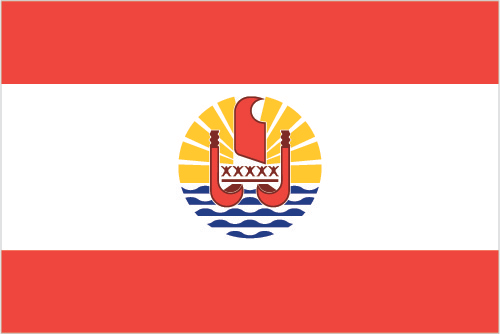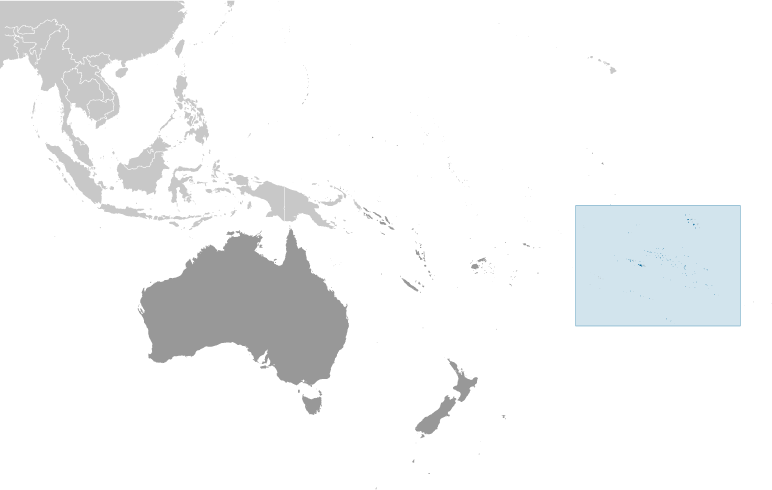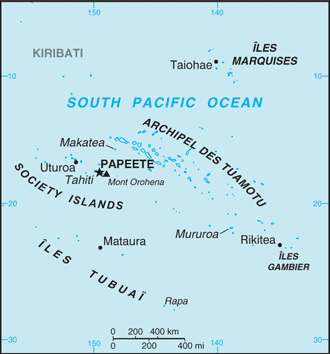



Australia-Oceania :: FRENCH POLYNESIA
Introduction :: FRENCH POLYNESIA
-
The French annexed various Polynesian island groups during the 19th century. In September 1995, France stirred up widespread protests by resuming nuclear testing on the Mururoa Atoll after a three-year moratorium. The tests were halted in January 1996. In recent years, French Polynesia's autonomy has been considerably expanded.
Geography :: FRENCH POLYNESIA
-
Oceania, five archipelagoes (Archipel des Tuamotu, Iles Gambier, Iles Marquises, Iles Tubuai, Society Islands) in the South Pacific Ocean about halfway between South America and Australia15 00 S, 140 00 WOceaniatotal: 4,167 sq km (118 islands and atolls; 67 are inhabited)land: 3,827 sq kmwater: 340 sq kmcountry comparison to the world: 175slightly less than one-third the size of Connecticut0 km2,525 kmterritorial sea: 12 nmexclusive economic zone: 200 nmtropical, but moderatemixture of rugged high islands and low islands with reefsmean elevation: NAelevation extremes: lowest point: Pacific Ocean 0 mhighest point: Mont Orohena 2,241 mtimber, fish, cobalt, hydropoweragricultural land: 12.5%arable land 0.7%; permanent crops 6.3%; permanent pasture 5.5%forest: 43.7%other: 43.8% (2011 est.)10 sq km (2012)the majority of the population lives in the Society Islands, one of five archipelagos that includes the most populous island - Tahiti - with approximately 70% of the nation's populationoccasional cyclonic storms in Januarysea level rise; extreme weather events (cyclones, storms, and tsunamis producing floods, landslides, erosion, and reef damage); droughts; fresh water scarcityincludes five archipelagoes: four volcanic (Iles Gambier, Iles Marquises, Iles Tubuai, Society Islands) and one coral (Archipel des Tuamotu); Makatea in the Tuamotu archipelago is one of the three great phosphate rock islands in the Pacific Ocean - the others are Banaba (Ocean Island) in Kiribati and Nauru
People and Society :: FRENCH POLYNESIA
-
287,881 (July 2017 est.)country comparison to the world: 181noun: French Polynesian(s)adjective: French PolynesianPolynesian 78%, Chinese 12%, local French 6%, metropolitan French 4%French (official) 70%, Polynesian (official) 28.2%, other 1.8% (2012 est.)Protestant 54%, Roman Catholic 30%, other 10%, no religion 6%0-14 years: 22.52% (male 33,340/female 31,481)15-24 years: 15.73% (male 23,533/female 21,745)25-54 years: 44.36% (male 65,464/female 62,254)55-64 years: 9.42% (male 13,947/female 13,178)65 years and over: 7.97% (male 11,090/female 11,849) (2017 est.)total dependency ratio: 45.3youth dependency ratio: 34.8elderly dependency ratio: 10.5potential support ratio: 9.5 (2015 est.)total: 31.9 yearsmale: 31.7 yearsfemale: 32.1 years (2017 est.)country comparison to the world: 1060.88% (2017 est.)country comparison to the world: 12314.8 births/1,000 population (2017 est.)country comparison to the world: 1315.2 deaths/1,000 population (2017 est.)country comparison to the world: 186-0.8 migrant(s)/1,000 population (2017 est.)country comparison to the world: 133the majority of the population lives in the Society Islands, one of five archipelagos that includes the most populous island - Tahiti - with approximately 70% of the nation's populationurban population: 55.7% of total population (2017)rate of urbanization: 0.86% annual rate of change (2015-20 est.)PAPEETE (capital) 133,000 (2014)at birth: 1.05 male(s)/female0-14 years: 1.06 male(s)/female15-24 years: 1.08 male(s)/female25-54 years: 1.05 male(s)/female55-64 years: 1.06 male(s)/female65 years and over: 0.94 male(s)/femaletotal population: 1.05 male(s)/female (2016 est.)total: 4.6 deaths/1,000 live birthsmale: 5.1 deaths/1,000 live birthsfemale: 4.1 deaths/1,000 live births (2017 est.)country comparison to the world: 178total population: 77.4 yearsmale: 75.1 yearsfemale: 79.8 years (2017 est.)country comparison to the world: 711.88 children born/woman (2017 est.)country comparison to the world: 1403.17 physicians/1,000 population (2009)improved:urban: 100% of populationrural: 100% of populationtotal: 100% of populationunimproved:urban: 0% of populationrural: 0% of populationtotal: 0% of population (2015 est.)improved:urban: 98.5% of populationrural: 98.5% of populationtotal: 98.5% of populationunimproved:urban: 1.5% of populationrural: 1.5% of populationtotal: 1.5% of population (2015 est.)NANANAtotal: 56.7%male: 54.5%female: 59.7% (2012 est.)
Government :: FRENCH POLYNESIA
-
conventional long form: Overseas Lands of French Polynesiaconventional short form: French Polynesialocal long form: Pays d'outre-mer de la Polynesie Francaiselocal short form: Polynesie Francaiseformer: French Colony of Oceaniaetymology: the term "Polynesia" is an 18th-century construct composed of two Greek words, "poly" (many) and "nesoi" (islands), and refers to the more than 1,000 islands scattered over the central and southern Pacific Oceanoverseas lands of France; overseas territory of France from 1946-2003; overseas collectivity of France since 2003, though it is often referred to as an overseas country due to its degree of autonomyparliamentary democracy (Assembly of French Polynesia); an overseas collectivity of Francename: Papeete (located on Tahiti)geographic coordinates: 17 32 S, 149 34 Wtime difference: UTC-10 (5 hours behind Washington, DC, during Standard Time)5 administrative subdivisions (subdivisions administratives, singular - subdivision administrative): Iles Australes (Austral Islands), Iles du Vent (Windward Islands), Iles Marquises (Marquesas Islands), Iles Sous-le-Vent (Leeward Islands), Iles Tuamotu-Gambier; note - the Leeward Islands and the Windward Islands together make up the Society Islands (Iles de la Societe)none (overseas lands of France)Fete de la Federation, 14 July (1790); note - the local holiday is Internal Autonomy Day, 29 June (1880)4 October 1958 (French Constitution)the laws of France, where applicable, applysee France18 years of age; universalchief of state: President Emmanuel MACRON (since 14 May 2017), represented by High Commissioner of the Republic Rene BIDALL (since 30 May 2016)head of government: President of French Polynesia Edouard FRITCH (since 12 September 2014)cabinet: Council of Ministers approved by the Assembly from a list of its members submitted by the presidentelections/appointments: French president directly elected by absolute majority popular vote in 2 rounds if needed for a 5-year term (eligible for a second term); high commissioner appointed by the French president on the advice of the French Ministry of Interior; French Polynesia president indirectly elected by Assembly of French Polynesia for a 5-year term (no term limits)description: unicameral Assembly of French Polynesia or Assemblee de la Polynesie Francaise (57 seats; elections held in 2 rounds; in the second round, 38 members directly elected in multi-seat constituencies by proportional representation vote; the party receiving the most votes gets an additional 19 seats; members serve 5-year terms)elections: last held on 21 April 2013 and 5 May 2013 (next to be held in 2018)election results: percent of vote by party - Popular Rally 45.1%, UPD 29.3%, A Tia Porinetia 25.6%; seats by party - Popular Rally 38, UPD 11, A Tia Porinetia 8note: 2 seats were elected to the French Senate for a 6-year term; last election on 20 September 2014 (next to be held in September 2022); election results - percent of vote by party - NA; seats by party - Popular Rally 1, People's Servant Party 1; 3 seats were elected to the French National Assembly for a 5-year term; last election on 17 June 2012 (next to be held by June 2017); election results - percent of vote by party - NA; seats by party - Tapura Huiractura 2, Tavini Huiraatura 1highest court(s): Court of Appeal or Cour d'Appel (composition NA); note - appeals beyond the French Polynesia Court of Appeal are heard by the Court of Cassation (in Paris)judge selection and term of office: judges assigned from France normally for 3 yearssubordinate courts: Court of the First Instance or Tribunal de Premiere Instance; Court of Administrative Law or Tribunal AdministratifA Tia Porinetia [Teva ROHFRITSCH]Alliance for a New Democracy or ADN (includes The New Star [Philip SCHYLE], This Country is Yours [Nicole BOUTEAU])New Fatherland Party (Ai'a Api) [Emile VERNAUDON]Our Home alliancePeople's Servant Party (Tavini Huiraatira) [Oscar TEMARU]Popular Rally (Tahoeraa Huiraatira) [Gaston FLOSSE]Tapura Huiraatira [Edouard FRITICH]Tavini Huiraatira [James CHANCELOR]Union for Democracy alliance or UPD [Oscar TEMARU]ITUC (NGOs), PIF (associate member), SPC, UPU, WMOnone (overseas lands of France)none (overseas lands of France)two red horizontal bands encase a wide white band in a 1:2:1 ratio; centered on the white band is a disk with a blue and white wave pattern depicting the sea on the lower half and a gold and white ray pattern depicting the sun on the upper half; a Polynesian canoe rides on the wave pattern; the canoe has a crew of five represented by five stars that symbolize the five island groups; red and white are traditional Polynesian colorsnote: identical to the red-white-red flag of Tahiti, the largest and most populous of the islands in French Polynesia, but which has no emblem in the white band; the flag of France is used for official occasionsoutrigger canoe, Tahitian gardenia (Gardenia taitensis) flower; national colors: red, whitename: "Ia Ora 'O Tahiti Nui" (Long Live Tahiti Nui)lyrics/music: Maeva BOUGES, Irmine TEHEI, Angele TEROROTUA, Johanna NOUVEAU, Patrick AMARU, Louis MAMATUI, and Jean-Pierre CELESTIN (the compositional group created both the lyrics and music)note: adopted 1993; serves as a local anthem; as a territory of France, "La Marseillaise" is official (see France)under certain acts of France, French Polynesia has acquired autonomy in all areas except those relating to police, monetary policy, tertiary education, immigration, and defense and foreign affairs; the duties of its president are fashioned after those of the French prime minister
Economy :: FRENCH POLYNESIA
-
Since 1962, when France stationed military personnel in the region, French Polynesia has changed from a subsistence agricultural economy to one in which a high proportion of the work force is either employed by the military or supports the tourist industry. With the halt of French nuclear testing in 1996, the military contribution to the economy fell sharply.After growing at an average yearly rate of 4.2% from 1997-2007, the economic and financial crisis in 2008 marked French Polynesia’s entry into recession. However, since 2014, French Polynesia has shown signs of recovery. Business turnover reached 1.8% year-on-year in September 2016, tourism increased 1.8% in 2015, and GDP grew 2.0% in 2015.French Polynesia’s tourism-dominated service sector accounted for 85% of total value added for the economy in 2012. Tourism employs 17% of the workforce. Pearl farming is the second biggest industry, accounting for 54% of exports in 2015; however, the output has decreased to 12.5 tons – the lowest level since 2008. A small manufacturing sector predominantly processes commodities from French Polynesia’s primary sector - 8% of total economy in 2012 - including agriculture and fishing.France has agreed to finance infrastructure, marine businesses, and cultural and ecological sites at roughly $80 million per year between 2015 and 2020. Japan, the US, and China are French Polynesia’s three largest trade partners.$5.49 billion (2015 est.)$5.383 billion (2014 est.)$6.963 billion (2010 est.)country comparison to the world: 170$4.795 billion (2012 est.)2% (2015 est.)-2.7% (2014 est.)-2.5% (2010 est.)country comparison to the world: 139$17,000 (2015 est.)$20,100 (2014 est.)$22,700 (2010)country comparison to the world: 98household consumption: 66.9%government consumption: 33.6%investment in fixed capital: 19.4%investment in inventories: 0.1%exports of goods and services: 17.5%imports of goods and services: -37.5%agriculture: 2.5%industry: 13%services: 84.5% (2009)coconuts, vanilla, vegetables, fruits, coffee; poultry, beef, dairy products; fishtourism, pearls, agricultural processing, handicrafts, phosphatesNA%126,300 (2016 est.)country comparison to the world: 180agriculture: 13%industry: 19%services: 68% (2013 est.)21.8% (2012)11.7% (2010)country comparison to the world: 18719.7% (2009 est.)lowest 10%: NA%highest 10%: NA%revenues: $1.891 billionexpenditures: $1.833 billion (2011)39.4% of GDP (2012)country comparison to the world: 411.2% of GDP (2012)country comparison to the world: 21calendar year0% (2015 est.)0.3% (2014 est.)country comparison to the world: 48$3.81 billion (2015 est.)country comparison to the world: 135$NA$207.7 million (2014 est.)$158.8 million (2013 est.)country comparison to the world: 49$1.245 billion (2014 est.)$1.168 billion (2013 est.)country comparison to the world: 152cultured pearls, coconut products, mother-of-pearl, vanilla, shark meatJapan 22.2%, Hong Kong 21.7%, Kyrgyzstan 16.8%, France 13.3%, US 12.6% (2016)$2.235 billion (2014 est.)$2.271 billion (2013 est.)country comparison to the world: 154fuels, foodstuffs, machinery and equipmentFrance 28.5%, South Korea 10.7%, US 9%, NZ 7.8%, China 7.2%, Singapore 5.9% (2016)$NA$905 million (2015 est.)$822.3 million (2014 est.)country comparison to the world: 119$349.3 million (2015)$310.8 million (2014 est.)country comparison to the world: 94Comptoirs Francais du Pacifique francs (XPF) per US dollar -110.2 (2016 est.)107.6 (2015 est.)89.85 (2013 est.)90.56 (2012 est.)85.74 (2011 est.)
Energy :: FRENCH POLYNESIA
-
population without electricity: 116,981electrification - total population: 59%electrification - urban areas: 72%electrification - rural areas: 45% (2012)626 million kWh (2015 est.)country comparison to the world: 161582.2 million kWh (2015 est.)country comparison to the world: 1690 kWh (2016 est.)country comparison to the world: 1380 kWh (2016 est.)country comparison to the world: 152249,000 kW (2015 est.)country comparison to the world: 16071.1% of total installed capacity (2015 est.)country comparison to the world: 1020% of total installed capacity (2015 est.)country comparison to the world: 9318.9% of total installed capacity (2015 est.)country comparison to the world: 9310.8% of total installed capacity (2015 est.)country comparison to the world: 680 bbl/day (2016 est.)country comparison to the world: 1390 bbl/day (2014 est.)country comparison to the world: 1260 bbl/day (2014 est.)country comparison to the world: 1300 bbl (1 January 2017 es)country comparison to the world: 1380 bbl/day (2014 est.)country comparison to the world: 1467,000 bbl/day (2015 est.)country comparison to the world: 1660 bbl/day (2014 est.)country comparison to the world: 1586,636 bbl/day (2014 est.)country comparison to the world: 1540 cu m (2013 est.)country comparison to the world: 1380 cu m (2013 est.)country comparison to the world: 1830 cu m (2013 est.)country comparison to the world: 1060 cu m (2013 est.)country comparison to the world: 1270 cu m (1 January 2014 es)country comparison to the world: 1421.1 million Mt (2013 est.)country comparison to the world: 164
Communications :: FRENCH POLYNESIA
-
total subscriptions: 94,957subscriptions per 100 inhabitants: 33 (July 2016 est.)country comparison to the world: 159total: 220,819subscriptions per 100 inhabitants: 77 (July 2016 est.)country comparison to the world: 180domestic: combined fixed-line and mobile-cellular density is roughly 110 per 100 personsinternational: country code - 689; satellite earth station - 1 Intelsat (Pacific Ocean) (2016)the publicly owned French Overseas Network (RFO), which operates in France's overseas departments and territories, broadcasts on 2 TV channels and 1 radio station; 1 government-owned TV station; a small number of privately owned radio stations (2008).pftotal: 195,275percent of population: 68.4% (July 2016 est.)country comparison to the world: 163
Transportation :: FRENCH POLYNESIA
-
number of registered air carriers: 2 (registered in France)inventory of registered aircraft operated by air carriers: 21 (registered in France) (2015)F-OH (2016)54 (2013)country comparison to the world: 87total: 45over 3,047 m: 21,524 to 2,437 m: 5914 to 1,523 m: 33under 914 m: 5 (2017)total: 9914 to 1,523 m: 4under 914 m: 5 (2013)1 (2013)total: 2,590 kmpaved: 1,735 kmunpaved: 855 km (1999)country comparison to the world: 171registered in other countries: 12 (Cambodia 1, France 11) (2010)country comparison to the world: 107major seaport(s): Papeete
Military and Security :: FRENCH POLYNESIA
-
no regular military forces (2011)defense is the responsibility of France
Transnational Issues :: FRENCH POLYNESIA
-
none
